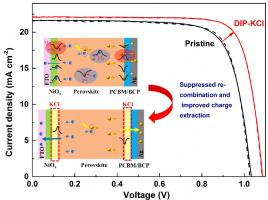Journal of Energy Chemistry ( IF 14.0 ) Pub Date : 2020-06-25 , DOI: 10.1016/j.jechem.2020.06.019 Shasha Zhang , Xiaobo Yan , Zonghao Liu , Hongmei Zhu , Zhichun Yang , Yuqian Huang , Sanwan Liu , Di Wu , Ming Pan , Wei Chen

|
Defect-induced charge carrier recombination at the interfaces between perovskite and adjacent charge transport layers restricts further improvements in the device performance of perovskite solar cells (PSCs). Defect passivation at these interfaces can reduce trap states and inhibit the induced nonradiative recombination. Herein, we report a double-sided interfacial passivation via simply evaporating potassium chloride (DIP-KCl) at both the hole transport layer (HTL)/perovskite and perovskite/electron transport layer (ETL) interfaces in inverted planar PSCs. We demonstrate that the bottom KCl layer at the HTL/perovskite interface not only reduces the interfacial defects and improves the interfacial contact, but also leads to increased perovskite crystallinity, while the top KCl layer at the perovskite/ETL interface efficiently passivates the perovskite top surface defects and facilitates electron extraction at this interface. Thus, suppressed nonradiative recombination and faster charge extraction at both interfaces close to the perovskite layer can be achieved by using our DIP-KCl strategy. As a result, inverted PSCs based on DIP-KCl present an increased efficiency from 17.1% to 19.2% and enhanced stability, retaining over 90% of their initial efficiency after aging at maximum power point tracking for 1000 h. This work provides a simple and efficient way for defect passivation to further increase the efficiency and stability of PSCs.
中文翻译:

蒸发氯化钾用于倒置平面钙钛矿太阳能电池的双面界面钝化
钙钛矿与相邻电荷传输层之间的界面处的缺陷诱导的电荷载流子复合限制了钙钛矿太阳能电池(PSC)器件性能的进一步提高。这些界面处的钝化钝化可以减少陷阱状态并抑制诱导的非辐射重组。在本文中,我们报告了通过简单地蒸发倒置平面PSC中的空穴传输层(HTL)/钙钛矿和钙钛矿/电子传输层(ETL)界面处的氯化钾(DIP-KCl)进行双面界面钝化。我们证明了HTL /钙钛矿界面处的底部KCl层不仅减少了界面缺陷并改善了界面接触,还导致钙钛矿的结晶度增加,钙钛矿/ ETL界面的顶层KCl层可有效钝化钙钛矿的顶部表面缺陷,并促进该界面处的电子提取。因此,通过使用我们的DIP-KCl策略,可以在钙钛矿层附近的两个界面处实现抑制的非辐射重组和更快的电荷提取。结果,基于DIP-KCl的倒装PSC的效率从17.1%提高到19.2%,并提高了稳定性,在最大功率点跟踪1000 h老化后,保留了其初始效率的90%以上。这项工作为缺陷钝化提供了一种简单而有效的方法,以进一步提高PSC的效率和稳定性。通过使用我们的DIP-KCl策略,可以在钙钛矿层附近的两个界面上抑制非辐射复合并加快电荷提取。结果,基于DIP-KCl的倒装PSC的效率从17.1%提高到19.2%,并提高了稳定性,在最大功率点跟踪1000 h老化后,保留了其初始效率的90%以上。这项工作为缺陷钝化提供了一种简单而有效的方法,以进一步提高PSC的效率和稳定性。通过使用我们的DIP-KCl策略,可以在钙钛矿层附近的两个界面上抑制非辐射复合并加快电荷提取。结果,基于DIP-KCl的倒装PSC的效率从17.1%提高到19.2%,并提高了稳定性,在最大功率点跟踪1000 h老化后,保留了其初始效率的90%以上。这项工作为缺陷钝化提供了一种简单而有效的方法,以进一步提高PSC的效率和稳定性。











































 京公网安备 11010802027423号
京公网安备 11010802027423号